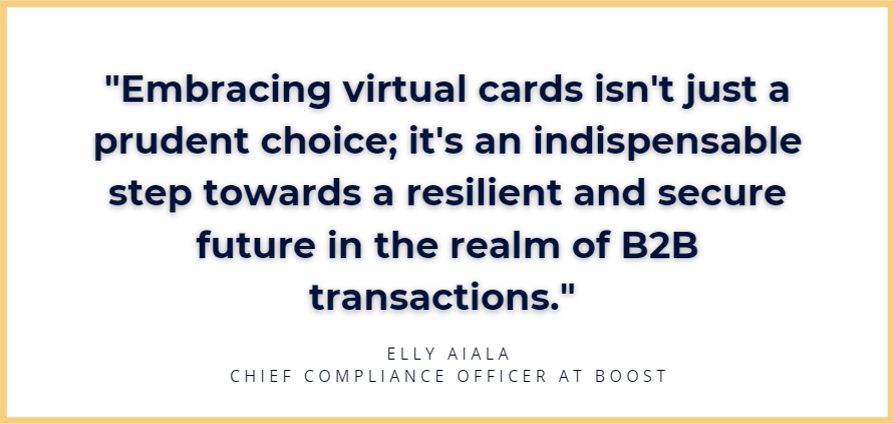Let’s face it – fraud isn’t going anywhere. With the rapid advancements of technology, the risk of fraud is only increasing. According to the 2023 AFP Payments Fraud and Control Survey, sixty-five percent of respondents indicated that their organizations were victims of either attempted or actual fraud activity in 2022, with sixty-three percent of respondents reporting that their fraud activity was mainly via checks.
As check fraud schemes become increasingly sophisticated, the need for more secure payment alternatives is needed now more than ever. Virtual card payments provide fraud protections that make them significantly safer than checks, perhaps the most convincing rationale for transitioning to this payment method. Our Chief Compliance Officer, Elly Aiala, seems to agree: “Embracing virtual cards isn't just a prudent choice; it's an indispensable step towards a resilient and secure future in the realm of B2B transactions."
So, what are the top 5 reasons why virtual cards are considered the most secure payment option for B2B clients? Let’s dive in.
1. No physical card
Virtual cards are digital representations of a physical card that are used to remotely make purchases in a digital environment. Since you have complete control over virtual cards, you can block or freeze these cards instantly with ease in case it is compromised. Think about it this way – you won’t have to deal with initiating a cancellation process, awaiting the issuance of a new card, and then dealing with a cumbersome dispute resolution procedure if the card number is lost, stolen, or compromised, like with a physical card.
2. Unique card numbers for each transaction
Virtual card payments are coded with a randomly generated 16-digit card number to be used for one single transaction for a specific payment amount. In order to make the payment, the user must have the correct authorization to do so. This enhances the security of the virtual credit card, as the primary user is the only one who can take advantage of this option, making it much more difficult for fraudsters to use the card number for unauthorized purchases or to steal sensitive data.
3. Maximum spending limit
Virtual cards allow you to set specific spending limits for each card to prevent overcharging. This enables better control over expenses and ensures that transactions do not exceed predetermined thresholds. For example, if your virtual credit card number is active and you’ve set a $100 limit on your virtual card, an untrustworthy merchant or an identity thief can’t charge more than that to the number.
4. Account number expiration
To ensure timely payment processing, virtual credit cards can be assigned expiration dates. In case a payment remains unprocessed within the permitted timeframe, the account number becomes invalid and cannot be charged. In other words, no one will be able to make a charge with your card after the set period of time has elapsed. The time can be as short as 24 hours, so even if a merchant with your virtual credit card number was hacked days after you made a purchase with them, you wouldn’t have to worry.

5. Automated deactivation
Upon successful payment processing, a virtual account number promptly transitions into an inactive state, making it unusable thereafter. This proactive measure significantly diminishes the likelihood of deliberate fraudulent activities, as well as unintentional occurrences of duplicate charges after the payment is complete.
A Safer Outlook with Virtual Cards
It’s no wonder why the virtual card global market was valued at USD 13.31 billion in 2022 and is anticipated to expand at a compound annual growth rate (CAGR) of 20.9% from 2023 to 2030, according to Grand View Research. As we see more businesses adopt virtual cards for their B2B transactions, we can begin to see benefits of reduced fraud risk and cyber threats globally, making virtual cards the most trusted payment method for businesses worldwide.
With Boost Payment Solutions, our patented technology maintains high levels of security and reduces fraud risk for buyers, suppliers, and financial institutions worldwide. In fact, over the last two years, Boost has successfully processed billions of dollars’ worth of payments with no fraud losses.
